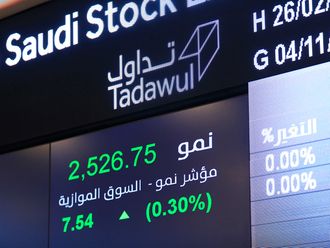New York/London: Gold fell on Friday, wiping out what would have been its first weekly gain since November, as traders priced the market lower while awaiting the outcome of last-ditch US budget talks before a year-end deadline.
Palladium saw the sharpest move of the day among precious metals. It gave back two-thirds of Thursday’s gains, which were the largest in a month, as funds that bought into that rally took profit. Platinum was technically oversold after falling nearly 12 per cent from an October peak.
Most markets were on tenterhooks as President Barack Obama scheduled a 3pm EST (2000 GMT) meeting at the White House with congressional leaders from the Democratic and Republican parties to restart stalled talks on the budget.
The dollar rose, US Treasury yields hit two-week lows and stocks on Wall Street headed for their longest losing streak in three months as the politicians sought to avoid $600 billion (Dh2.2 trillion) in tax increases and spending cuts set to take effect on January 1.
Failure to reach a deal will tip the US economy over a “fiscal cliff” and into possible recession, economists warn.
By 3.30pm (2030 GMT), the spot price of gold was hovering around $1,656 an ounce, versus Thursday’s last bid at $1,663.29.
US gold futures for February delivery settled down $7.80, or 0.5 per cent, at $1,655.90 an ounce in New York.
Traditionally a safe haven and inflation hedge that investors rush to in times of trouble, gold has lately behaved like a risk asset — often rising and falling with the stock market and sometimes following the dollar
Little light on gold direction
Spot gold and futures showed a modest loss on the week after Friday’s decline wiped out gains built from Monday through Thursday. Despite the somewhat surprising swing, most dealers found this week’s moves in gold too puny for a market that had been modelled as a key hedge to the US fiscal crisis.
“It strikes me that the gold market really doesn’t quite know where to go at this moment,” said Adrian Day at Adrian Day Asset Management in Annapolis, Maryland.
“Light trading in the holidays obviously has a distorting effect on prices but if anything, the moves should be exaggerated, not muted like this.”
In Friday’s session, volume in gold futures was around 60 per cent below the 30-day average, making it one of the least traded markets on the 19-commodity Thomson Reuters-Jefferies CRB index.
Although they have moderated now, gold prices ran up sharply in the first and third quarters of this year, aided by ultra-loose monetary policy in the world’s leading economies, bullion buying by central banks trying to diversify foreign reserves and concerns over the financial stability of the Eurozone.
The rally in those quarters has given gold a 6 per cent gain on the year, extending its winning streak to a 12th year.
Safe-haven buying buffet market
Analysts said heavy profit-taking in gold over the past month — as some bullion owners try to cash in this year’s gains — may be offsetting any rally culminating from those buying gold as a safe haven.
“The fiscal cliff only tells one half of the story in gold right now,” said Edmund Moy, chief strategist at Morgan Gold in Irvine, California.
“The reality is a lot of supply has come on to the market in the last month, mainly due to people selling gold for profit to avoid higher capital gains taxes next year. The additional supply, combined with the fiscal uncertainties, is causing the flattish market.”
The industry-backed World Gold Council said it expected the rally in bullion to extend into a 13th year in 2013, helped by growing demand for gold in China and India.
India, the biggest buyer of gold, was stocking aggressively for its traditional festive and wedding season, but retail and investment demand for bullion remained sluggish, traders said.
Palladium consolidates, platinum under pressure
In industry news, a South African lawyer moved to file a class action suit against more than 30 gold firms on behalf of 17,000 former miners who say they contracted silicosis, a debilitating lung disease, due to negligence in health and safety.
In other precious metals, silver was down 0.5 per cent at $30 an ounce, while palladium dipped 2 per cent to $692.47 and platinum eased 1 per cent to $1,516.50.
Palladium surged 2.4 per cent in Thursday’s session, continuing a bullish trend set since November 13 by a report from refiner Johnson Matthey projecting the biggest supply deficit in 11 years in the metal largely used an auto catalyst.
“Funds have been after palladium ever since that JM report came out. There was very, very heavy buying yesterday, led by undisclosed fund out of London,” said Frank McGhee, head precious metals at Integrated Broking Services in Chicago.
As for platinum, its relative strength index (RSI) fell to around 30, an area traditionally seen as oversold territory.
“At this point, if there’s any other pressure on platinum, it could see a fairly vicious break down. There’s really nothing to hold the market up,” McGhee said.
Platinum hit eight-month highs above $1,725 an ounce in September after sprawling labour unrest at some mines in top producer South Africa halted production and sparked supply concerns. Worker strikes at the mines wound down in late October, putting platinum prices on the defence since.












